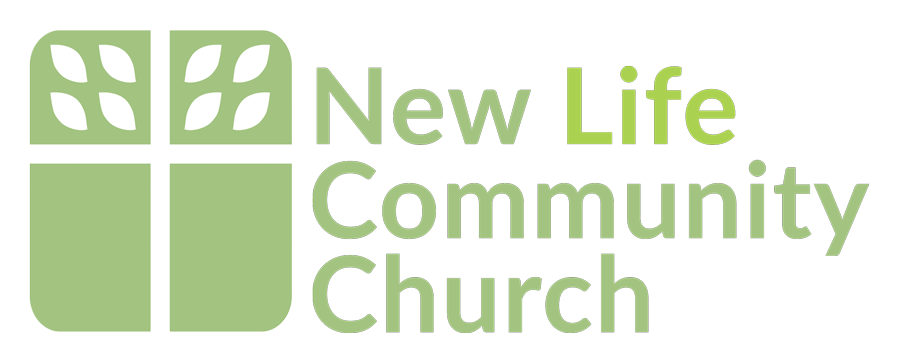THE PROPHETIC PICTURE OF CHRIST IN THE TABERNACLE
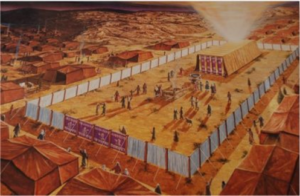 We have come to the section of the Old Testament in which the Lord commands that a portable Tabernacle be built to accompany the people of God in the wilderness. Everything about its construction was to be precisely according to the pattern that the Lord gave to Moses because it would represent a spiritual reality that eventually would be fully communicated through the person of Jesus Christ (Exodus 25:9, Hebrews 8:5).
We have come to the section of the Old Testament in which the Lord commands that a portable Tabernacle be built to accompany the people of God in the wilderness. Everything about its construction was to be precisely according to the pattern that the Lord gave to Moses because it would represent a spiritual reality that eventually would be fully communicated through the person of Jesus Christ (Exodus 25:9, Hebrews 8:5).
The Tabernacle was to be a meeting place where God would make Himself known to His people. It was sometimes called “the tent of meeting” (Exodus 29:42), or “the Tabernacle of the testimony” (Exodus 38:21; Numbers 1:50). Its construction and prescribed service would put the plan of redemption on display, ‘the secret of the tabernacle’ (Psalm 27:5). It illustrates how fellowship with the One true holy God is made possible through the redemptive work of the perfect Mediator, the Messiah (Anointed One), the Greater High Priest, Christ Jesus.
The Bible describes the creation of the physical, visible world in 31 verses in the Book of Genesis. The creation of the place of worship, (the Tabernacle), is given far more attention, requiring 243 verses. In the Book of Exodus, the Tabernacle is the subject of Chapters 25-40. It is obviously very important that we know Whom we worship, why we worship and how to worship. These truths will be displayed in the tabernacle. Jesus said, “God is spirit, and His worshipers must worship in spirit and in truth” (John 4:24).
The details pertaining to the construction of the Tabernacle help us to understand that worship must be on God’s terms (in spirit and in truth) and not our own. The instructions given to Moses unfold a prophetic pattern reflecting the gospel, the good news of Who God is and what He has done through the person of His Son. This pattern can be seen in all that is prescribed. The attitudes of willing, sacrificial obedience in the hearts of the worshipers, the construction materials, their assembly, the prescribed furnishings and their placement within the Tabernacle structure, and the service of the Tabernacle itself, all speak of Christ.
- THE TABERNACLE MUST BE BUILT WITH THE COOPERATION OF A WILLING SACRIFICIAL HEART
Exodus 25:2 (NIV) 2 “Tell the Israelites to bring me an offering. You are to receive the offering for me from each man whose heart prompts him to give. (See how this is wonderfully fulfilled in Exodus 36:2-7).
It is fulfilled in a greater way in Christ:
Hebrews 10:5-7 (NIV) 5 Therefore, when Christ came into the world, he said: “Sacrifice and offering you did not desire, but a body you prepared for me; 6 with burnt offerings and sin offerings you were not pleased. 7 Then I said, ‘Here I am–it is written about me in the scroll– I have come to do your will, O God.'”
- THE TABERNACLE WOULD BE BUILT OF CERTAIN MEANINGFUL ELEMENTS
Exodus 25:3-8 3 “This is the contribution which you are to raise from them: gold, silver and bronze, 4 blue, purple and scarlet material, fine linen, goat hair, 5 rams’ skins dyed red, porpoise skins, acacia wood, 6 oil for lighting, spices for the anointing oil and for the fragrant incense, 7 onyx stones and setting stones for the ephod and for the breastpiece. 8 “Let them construct a sanctuary for Me, that I may dwell among them”.
- Gold– symbolizes the Divine Nature- this would feature in the furnishings in the Holy Place and the Holiest of all. It would overlay the acacia wood, which represents the incorruptible humanity of Christ.
- Silver– symbolizes Redemption and atonement money (Gen 37:28; Exodus 21:32; 30:11-16; Zech 11:12; Matt 27:3); this would feature in the footings and connection rods in the Tabernacle.
- Bronze– symbolizes Judgment against sin; this features in the brazen altar (prefiguring the cross of Christ) where sin is judged. The foundation sockets and pillars for the fence posts were of brass (Numbers 21:9; John 3:14; Deut 28:23; Rev 1:15).
- Blue– stands for heavenly authority, Purple for royalty, and Scarlet, the sacrificial color-symbolizing the blood of the atoning sacrifices. These colored yarns are to adorn the veil that separates the Holy Place from the Holiest of All.
- Fine twined linen represents the righteousness (Rev 19:8) that comes from a seed falling into the ground and rising (John 12:24); not a fabric from an animal, but from a flax plant. It is a fabric that does not cause sweat (which would imply our own works).
- Goat’s hair, tanned ram’s skins and goat skins are featured in the outside coverings of the tent. Inside the tent only linen and precious materials were visible- representing what is made known through the revelation of the Word- what eye has not seen and ear has not heard. On the outside the Tabernacle looked very common, as its coverings were of materials familiar to the region, reminding us of the prophetic picture of Christ in Isaiah 53:2: “He had no beauty or majesty to attract us to him, nothing in his appearance that we should desire him.”
- Acacia wood– was a durable wood speaking of incorruptible humanity. We see how the ark of the covenant is constructed of acacia wood covered with gold, a perfect picture of Jesus Christ who is fully God and fully man, yet man without sin. The boards of the Tabernacle wall were constructed of acacia wood.
- Oil for the lamps- Oil speaks of the Holy Spirit fueling the illumination of the Holy Place through the golden lampstand.
- Spices for the anointing oil and fragrant incense. (This will be explained further in Exodus 30:1-10; 22-38).
- Precious stones for the breastplate of the High Priest which will represent the 12 tribes of Israel, the people of God.
The first Tabernacle was made of silver and gold. The Tabernacle of God in Jesus is made of flesh and blood.
John 1:14 (NIV) 14 The Word became flesh and made his dwelling among us. We have seen his glory, the glory of the One and Only, who came from the Father, full of grace and truth.
The Tabernacle of God in the Book of Revelation is made of redeemed “in Christ ones” and is foreshadowed by the Tabernacle in the wilderness.
Revelation 21:2-3 (NASB) 2 And I saw the holy city, new Jerusalem, coming down out of heaven from God, made ready as a bride adorned for her husband. 3 And I heard a loud voice from the throne, saying, “Behold, the Tabernacle of God is among men, and He will dwell among them, and they shall be His people, and God Himself will be among them,
The Illustrated Bible Dictionary records a summary description: 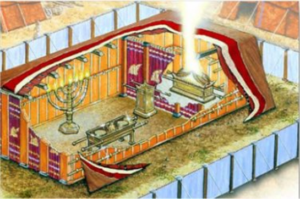
The Tabernacle was a rectangular enclosure, in length about 45 feet (i.e., reckoning a cubit at 18 inches) and in breadth and height about 15. Its two sides and its western end were made of boards of acacia wood, placed on end, resting in sockets of brass, the eastern end being left open (Ex 26:22). This framework was covered with four coverings, the first of linen, in which figures of the symbolic cherubim were wrought with needlework in blue and purple and scarlet threads, and probably also with threads of gold (Ex 26:1-6; Ex 36:8-13). Above this was a second covering of twelve curtains of black goats’-hair cloth, reaching down on the outside almost to the ground (Ex 26:7-11). The third covering was of rams’ skins dyed red, and the fourth was of badgers’ skins (Heb. tahash, i.e., the dugong, a species of seal), Ex 25:5; Ex 26:14; Ex 35:7, 23; Ex 36:19; Ex 39:34. –Illustrated Bible Dictionary: And Treasury of Biblical History, Biography, Geography, Doctrine, and Literature.
- THE TABERNACLE’S FURNISHINGS SPEAK OF CHRIST
THE ARK OF THE COVENANT– (Exodus 35:10-22) This is the first-mentioned furnishing of the Tabernacle and will serve as its central feature, and the only feature in the Holiest of All. It is here, before this uniquely constructed chest, that the High Priest on the Day of Atonement will commune with the glory of God. He can only do this if the prerequisite is made- the blood of the atoning sacrifice is sprinkled on the pure gold mercy seat covering over the ark. The mercy seat is on top of the ark of the testimony which contained the Pot of Manna (Christ as the Bread of Life), the Tables of Stone (Christ who fulfills the Law, Matt 5:17 and is the end of the law- Romans 10:4), and the Rod that budded (Numbers 17:10; John 11:25 – Christ as the Resurrection and the Life). The blood is witnessed by the golden cherubim, representing those angelic beings who were originally stationed as protectors of God’s holiness outside the gates of Eden with their drawn swords. Only when the blood is on the mercy seat could the shekinah glory of God’s presence fill the Holiest of All. 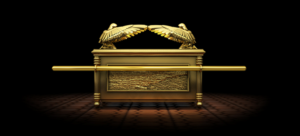
Exodus 25:22 (NASB) 22 “There I will meet with you; and from above the mercy seat, from between the two cherubim which are upon the ark of the testimony, I will speak to you about all that I will give you in commandment for the sons of Israel.
THE TABLE OF BREAD- (Exodus 25:23-30) This was constructed so that a dozen flat loaves of bread, positioned in two piles of six (Lev 24:6) shall be presented before the Lord, and flagons and cups can rest for the drink offerings to be poured out before the Lord. The table was constructed of acacia wood (incorruptible humanity) covered with gold (deity)- of the same substance as the ark. It pictures all that the people of God (symbolized by the number 12) offered before the Lord as those who have been baked into the loaf of Christ (identified with Christ).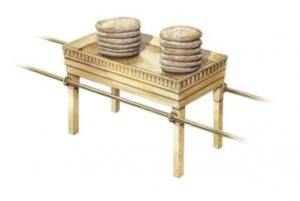
THE GOLDEN LAMPSTAND (Exodus 25:31-40)
There are seven flames with three branches on each side of a central branch. The number seven speaks of perfection (meaning ‘enough’ in Hebrew). It reminds us of the sevenfold spirit of the Lord (Isaiah 11:3). Each branch of the lampstand was ornamented with almond buds. Almond means ‘wakener’ and ‘hastener’. It is the first tree to waken in the spring- the first fruit of all trees. Aaron’s rod budded and this was a picture of resurrection life. Zechariah’s vision of the lampstand signified the ministry of the Holy Spirit (Zech 4:6). The lampstand provides the only illumination for the Holy Place except when on the Great day of Atonement the blood is applied to the mercyseat over the Ark in the innermost sanctuary. Then the light of the light of the Shekinah glory will spill through the veil.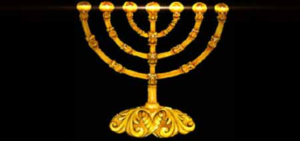
THE COVERINGS (CURTAINS, COVERINGS, FRAMEWORK) (Exodus 26:1-30)
There were four covering of curtains looped together that were placed over the top and fell over the side. The inside layer was of linen, embroidered with figures of cherubim in blue, purple and scarlet, looped together with golden fastening. The second layer, covering the linen, was of goat’s hair, the third, of ram’s skin dyed red, and the outermost has been described as a more repellant skin of badger, seal, or porpoise.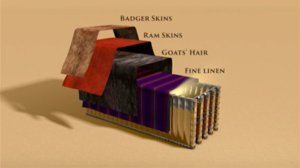
The tent is united with fifty clasps of bronze (Exodus 26:11) on each constructed long curtain being looped together. It is a wonderful picture of the Holy Spirit (given at Pentecost (50) making us all one, united in the bond of peace (Eph 4:3-4) 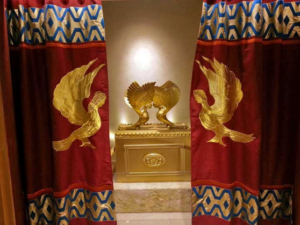
THE VEIL– (Exodus 26:31-37) This curtain divided the Holy Place (the middle sanctuary) from the Holiest of All (the Inner Sanctuary). The embroidered cherubim, those angelic beings appointed to uphold God’s standards of holiness, are pictured on the veil, and exclude mankind from communing with God. No one can enter the Holiest of All but the High Priest on one appointed day of the Year, the Great Day of Atonement. And he could not enter without the blood of the Atoning Sacrifice.
THE BRONZE ALTAR (Exodus 27:1-8) This altar, constructed of bronze, one source being from the mirrors of the Egyptians, was where the Priest would make atoning sacrifices for the sins of God’s people through the vicarious offering of animal substitutes. It represents the Cross. It is positioned at the door. You cannot and must not avoid it. There is no approach to God apart from the Cross. It was 5 cubits by 5 cubits and 3 cubits high. It is the largest item of the tabernacle. It is said that the other items could fit inside it. The word ‘altar’ means ‘lifted up’. Jesus said, “If I be lifted up..” (John 3:14). The altar is the way to God. It is the ladder of Jacob. It lifts us up as accepted in Christ’s righteousness and gives us access to communion with God in the Holy Place through the perfections of the Holiest of All. Fire would burn continually on the altar speaking of God’s continual judgment on sin. Ashes would drop through the grate. Ashes speak of our lives being reduced to its common denominator. It is the proof that judgment has been received through the finished work of Christ.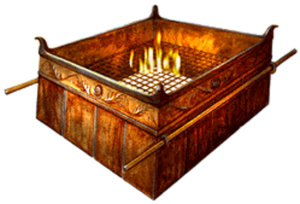
THE COURT OF THE TABERNACLE (Exodus 27:9-21) This is where the animals would be received by the priests and the sacrifices would be made. In future readings we will learn more about the furnishings and the service that takes place here.
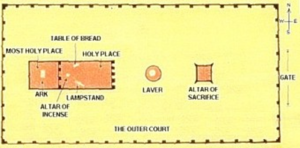
NEW TESTAMENT READING: MATTHEW 25:1-30
Our reading today consists of the parables that Jesus gives on the Mount of Olives. This is the Mount that overlooks Jerusalem and the Mountain from which Jesus will ascend (Acts 1:12) and return (Zechariah 14:4). These parables have to do with the Day of the Lord and His people being ready to meet Him when He does return.
Parable of the Ten Bridesmaids (Matt 25:1-13) God often refers to Himself as the husband of Israel. (Isaiah 54:4-6). Jesus refers to Himself as the Bridegroom (Matt 9:14-15). Jews and Gentiles have been invited to the wedding. In Hebrew weddings the wedding time was set by the Father. The Father had to inspect the wedding chamber, which often was an addition made to the Father’s house. Only with the Father’s approval, could the wedding take place. Only the Father knew the hour that the Bridegroom would return.
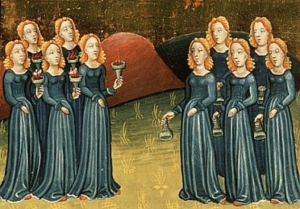
Jesus’ words to his disciples in the Upper Room reflected the speech of a young man proposing to marry his intended spouse: “In My Father’s house are many dwelling places; if it were not so, I would have told you; for I go to prepare a place for you. If I go and prepare a place for you, I will come again and receive you to Myself, that where I am, there you may be also” (John 14:2-3).
Once the Father gives the approval, the friend of the bridegroom announces the wedding. It could be at any hour and the bridesmaids need to be ready. Those who really anticipated the wedding would have had an oil supply (speaking of the Holy Spirit) as well as trimmed wicks. The parable teaches that you cannot borrow regeneration of the Spirit from another. We are born again of the Spirit as we trust Jesus Christ as our only true Savior and repent of trusting in false Saviors.
Parable of the Three Servants (Sometimes referred to as the Parable of the Talents) Matthew 25:14-30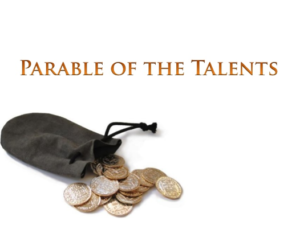
This is a powerful parable on stewardship. What do we do with what God has given us to bless others and bring a return of the wonderful investment He has made in our lives? He has given us time, opportunities, learnings, relationships, spiritual gifts, talents and abilities. To bury our talent, sit on it, and not use it for the purpose He has given it shows that we have no appreciation for the grace that we have received.
Let us all live our lives fully for God’s glory, stewarding all that we have been given by God’s grace, so that in that Great Day we will hear the words:
‘Well done, good and faithful slave. You were faithful with a few things, I will put you in charge of many things; enter into the joy of your master.’ Matthew 25:21 (NASB)
TODAY’S READING FROM THE BOOK OF PSALMS- Psalm 31:1-8
No matter how difficult the situation may be, we should recognize that the Lord is faithful and a refuge. The Psalmist says the words that will be upon Jesus’ lips on the cross, “Into Your hand I commit my spirit.” (Psalm 31:5) In the midst of misery, we can find mercy, for the Lord is a rock of refuge for those who trust in Him.
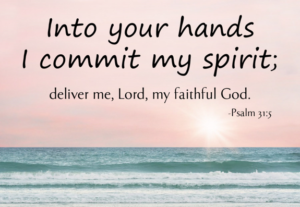
TODAY’S READING FROM THE BOOK OF PROVERBS- Proverbs 8:1-11
Wisdom is personified and is heard calling to sinners, beseeching them to be reconciled to God. Wisdom speaks ‘noble things’ ‘right things’, ‘truth’, ‘righteousness’, with no wickedness, nothing crooked, or perverted. Wisdom’s speech is straightforward. We would do well to take her instruction, and value it more than jewels, silver or gold. “All desirable things cannot compare with her.”
Mark Twain is credited as saying, “It isn’t what I don’t understand about the Bible that worries me, it is what I do understand.”
Are you inclining your ear to wisdom today?
PRAYER: Gracious God and Father we thank You for the beauty of Your Tabernacle! Thank You for Your self-revelation through the Word. You were making known Your grace and truth in the Tabernacle of Moses. How much more fully You made Yourself known in the person of Your Holy Son Jesus. We thank You for the work of redemption, the forgiveness of our sins, and the reconciliation that makes it possible for us to be Your dwelling place! May Your glory, the glory of our Lord and Savior Jesus Christ, be seen in us, and in Your church worldwide, both now and forever. In His matchless Name we ask it. Amen.
Pastor David
